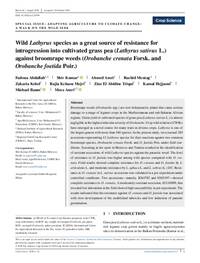Wild Lathyrus species as a great source of resistance forintrogression into cultivated grass pea (Lathyrus sativus L.)against broomrape weeds (Orobanche crenata Forsk. andOrobanche foetida Poir .)

Authors:
Broomrape weeds (Orobanche spp.) are root holoparasitic plants that cause serious damage to a range of legume crops in the Mediterranean and sub‐Saharan African regions. Grain yield of cultivated species of grass pea (Lathyrus sativus L.) is almost negligible at the highest infection severity of Orobanche. Crop wild relatives (CWRs) have emerged as a novel source for many traits in diverse crops. Lathyrus is one of the largest genera with more than 160 species. In the present study, we screened 285 accessions representing 13 Lathyrus species for their reactions against two common broomrape species, Orobanche crenata Forsk. and O. foetida Poir, under field conditions. Screening at hot spots in Morocco and Tunisia resulted in the identification of resistant accessions of wild Lathyrus species against the parasitic weed. The level of resistance to O. foetida was higher among wild species compared with O. crenata. Field results showed complete resistance for O. crenata and O. foetida by L. articulatus L. and moderate resistance by L. aphaca L. and L. ochrus (L.) DC. Resistance to O. crenata in L. sativus accessions was validated in a pot experiment under controlled conditions. Two accessions—namely, IG64782 and IG65197—showed complete resistance to O. crenata. A moderately resistant accession, IG116989, that revealed low infestation in the field showed high susceptibility in pot experiment. The results indicated that the resistance against O. crenata and O. foetida was associated with slow development of the established tubercles and low induction of parasite germination.
